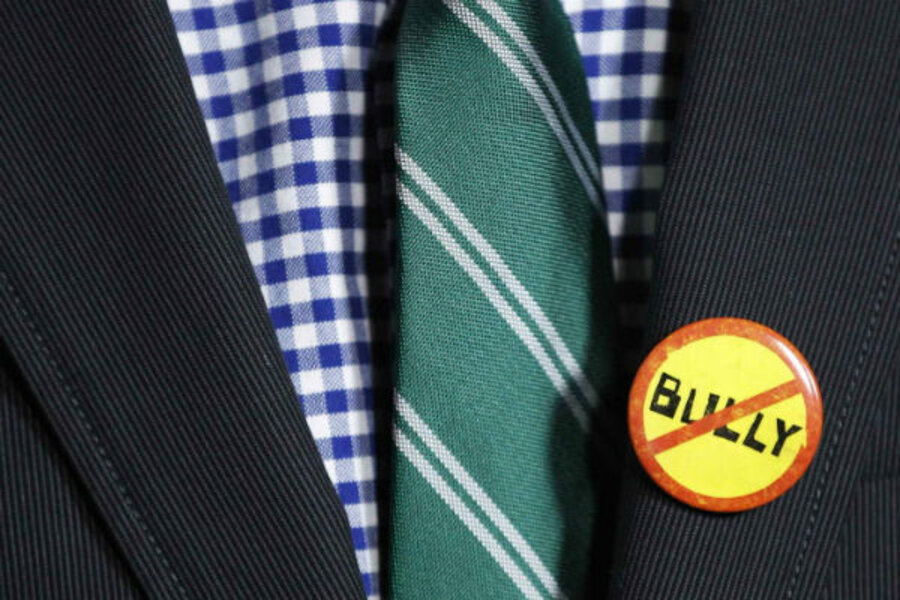Bullying: Teens take the lead as anti-bullying mentors, advocates
Loading...
Probably any number of things could inspire a student to become an activist, but in 16-year-old Ali’s case, it was “an English homework assignment about marginalized groups in society,” The Gazette, in Lisbon, Iowa, reported. “She realized they needed a voice,” apparently thought about how kids can get marginalized in bullying types of situations, and e-mailed Lisbon Community Schools’ dean of students, Terese Jurgensen with an idea for a bullying prevention program. Apparently Ms. Jurgensen was impressed with the thoughtfulness of Ali’s message and offered her support.
“A gathering of a few student council representatives led to the initiative for ‘The Voice’,” a program that has high school student council members both teaching and supporting elementary students on an ongoing basis (the older students go to elementary classes two to three times a month and become their “hallway friends” in this K-12 school).
All 28 members of the volunteer council supported the idea, which was key to the program’s success.
In what sounds like very wise advice, Jurgensen and her fellow administrators told these student activists, “You have to live it. You have to teach it.” The high school students knew younger students looked up to them but now they were becoming role models. “In an October retreat the council identified types of bullying – physical, verbal, cyber – as well as social alienation and intimidation. It came up with a three-point pledge: be strong, stand up, use your voice.”
They were teaching and modeling resilience, standing up for oneself and a community’s norms, and being good to people – knowing they had a kind of credibility with younger students that the adults at school didn’t have.“Success is evident,” the Gazette reported.
One of the student council members told The Gazette that she learns more about what works every time she visits an elementary classroom. That’s a good teacher, eh?
As for what motivated student activist Torin Hovander in Albuquerque, N.M., “a few of my friends and I decided that we didn’t like what was going on in not just our school but in schools all across the country,” he e-mailed me. So Torin, a senior, and his friends started a bullying prevention and awareness-raising club at his high school last September.
Now the Sandia High School club’s Facebook group has 363 members and support from alumni now attending the University of New Mexico. Torin told KOAT TV that they aim to have clubs in all 13 Albuquerque high schools by the beginning of next school year. As in the Lisbon, Iowa, school, this movement, as Torin called it, includes high school students teaching and mentoring younger students.
And the stories are multiplying!
Then there’s freshman Aidan McDaniel and friends’ “friend zone” at his school in West Virginia, a safe place in the cafeteria where students who don’t at the moment or yet have friends to sit with can eat lunch in peace, with fellow students who care.
Both Torin and Aidan participated in the launch symposium of Lady Gaga’s Born This Way Foundation at Harvard Law School’s Berkman Center for Internet & Society this past February, advising us adults on grassroots (student) action. And of course there were the two upperclassmen in a Nova Scotia, Canada, high school who several years ago went to bat for a younger student who was being harassed for wearing a pink shirt. They wore pink shirts to school in solidarity and started a movement that spread nationwide – and now Canada has a Pink Shirt Day.
For many more examples of young activists, change agents, and heroes, check out Sprigeo’s Heroes Project.
There are so many things about these social-good projects to celebrate, including that young people aren’t waiting around for adults to end bullying and social aggression, are taking positive, supportive action in diverse ways that are meaningful to them, are showing a remarkable level of commitment to solving social aggression problem. And they instinctively get what the research says: that the solution is not punishing individuals but changing the community’s culture.And finally, they're creating that school climate through a collective, whole-school approach.
They are modeling the respect they so deserve!
The Christian Science Monitor has assembled a diverse group of the best family and parenting bloggers out there. Our contributing and guest bloggers are not employed or directed by the Monitor, and the views expressed are the bloggers' own, as is responsibility for the content of their blogs. Anne Collier blogs at NetFamilyNews.







